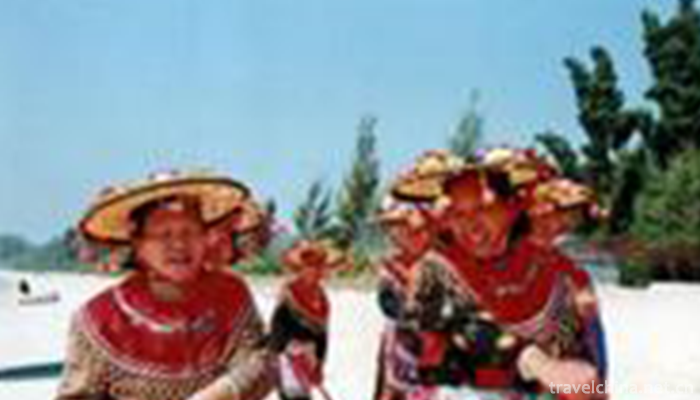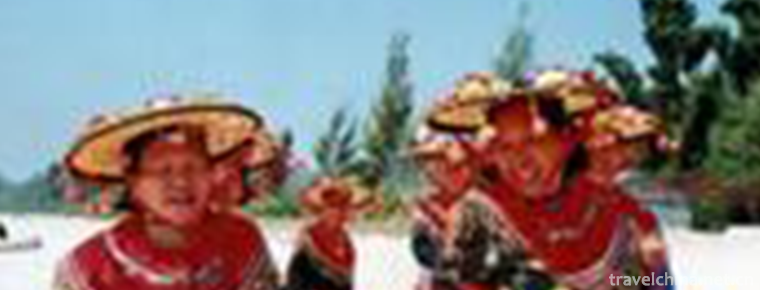Huidong Fishing Song
Huidong Fishing Song
Huidong Fishing Song is one of the traditional folk arts in Guangdong Province. From the Song Dynasty, fishing songs in the shallow sea of Huidong were introduced from the coast of Fujian Province.
"Huidong Fishing Song" is a folk song with distinctive features in "Chinese Fishing Song". It has the charm of the sea and the strong characteristics of the southern coastal culture. It is a colorful folk song bred by our Chinese nation in the long river of cultural history.
On June 7, 2008, Huidong Fishing Song of Huizhou City, Guangdong Province, was approved by the State Council to be included in the second batch of national intangible cultural heritage list. Heritage serial number: 592 II-93.
historical origin
"Huidong Fishing Song" is popular in ports of Huidong County, Fangang of Zishan Mountain, New Fishing Village of Yanzhou and New Fishing Village of Simiao County. The local people call it "the song of the silver carp boat" or "the song of the city", which belongs to the shallow sea fishing song of "the Fishing Song of Eastern Guangdong". It shares the same song with fishing villages in some coastal cities and counties of Guangdong Province, such as Shanwei, Haifeng, Baoan and Huiyang. It is similar to fishermen's customs and singing styles in the above places. However, due to their long-term living in different areas, influenced by local customs, language, culture, temple music, local operas and folk minors, the singing style of the same Fishing Song is slightly different and has its own characteristics.
artistic characteristics
artistic form
Huidong fishing songs have more than 20 varieties, such as "Ah aroma tune", "La Ti Ti Ti Ti Ti tune", "Ha ha aroma tune", "Xiandi tune" and "Luo Yin tune". Only the fishermen singing on the boat, there are solo and chorus, fishermen live in groups with "answer song" (that is, song, or fighting song) as music, no musical instrument accompaniment; its melody has a strong local opera music and temple music flavor; the lyric structure is mostly upper and lower sentences, one echo one sentence. The simplicity and conciseness of lyrics can be used for reference and inspiration in the creation of modern lyrics.
Representative works
The large-scale opera "The Great Wall of the South China Sea" and so on.
Huidong's program "Yujiale" won the silver prize.
Huidong Fishing Song was transmitted from Fujian coast to Huidong. This kind of fishing song sung in "Fulao dialect" (belonging to the southern Fujian language family) flowed into Huidong Port, Pinghai and Shanliao during the Song Dynasty. Singing fishing songs for more than a thousand years, but in recent years, because the local people who can speak pure "Fulao dialect" are increasingly scarce, facing the embarrassment of no one to praise. Fortunately, in order to preserve the art handed down by our ancestors, folk Fishing Song lovers took action to collect lyrics, music scores and adapt them to the stage. The government is also preparing to shoot movies and TV plays to make fishing songs beautiful and pleasant while maintaining the original ecology.
Inheritance and protection
Inheritance status
It is understood that there are only 10 elderly fishing singers in Huidong.
The fishing songs of Huidong were badly damaged in the ten years of catastrophe, and the fishermen who washed their feet and went ashore ushered in a new era. The fishing songs that everyone knew well before and could sing were gradually forgotten. Only on the occasions of sacrifice, festivals, weddings and funerals in fishing villages, can we hear the classical fishing songs that are lingering. In the whole Huidong area, there are only thirty or forty people who can sing fishing songs, basically over the age of fifty or sixty. Speaking of this, Ye Lao felt a little sad and expressed regret in his eyes. However, he was pleased to say that the local people were very active, and grass-roots Party committees and administrative leaders also attached great importance to fishing songs. "Their enthusiasm ignited my confidence."
Huidong Fishing Song has a variety of tunes and unique melody. It also provides rich and precious materials for music creation. Many songwriters came to Huidong fishing village to collect customs and create a large number of works on fishing songs. Huidong Fishing Song is a precious heritage of Chinese regional culture, but it is in danger of losing its heritage.
Inheritance and protection
Out of cherishing folk art, Ye Lin wrote a letter to the provincial Party committee leaders, calling for attention to the plight of Huidong fishing songs on the verge of being lost, and talked about his vision of saving Huidong fishing songs. The letter received high attention from Zhu Xiaodan and other provincial Party Committee leaders. After approval and photocopying, it was sent to Party committees at all levels.
Xu Twenty-four, a 92-year-old villager in Fanhe Town of Zishan, is the oldest Huidong fishing singer and one of the few second-generation inheritors.
At present, Ye Lin began to classify and sort out the fishing songs. Five or six of the most typical fishing songs were arranged into simple music scores, and two versions of the lyrics in Putonghua and Fulao dialect were also planned.
The Development of Fishing Songs Should "Move without Change"
Towards the end of the interview, the old man hummed a Huidong fishing song he arranged for us...
Last year, the Cultural Department of Guangdong Province declared Huidong Fishing Song as a national intangible cultural heritage to the central government. The next work is to promote and develop fishing songs.
Yelin believed that there should be different ways for different objects. On the standpoint of professional musicians, Ye Lin pointed out that the simple use of Fishing Song material for song creation can not meet the development needs of fishing song. We should follow the principle of "moving without changing shape", write new words on the basis of retaining the basic melody and flavor of fishing song, so that fishing song can meet the aesthetic needs of modern people and express the feelings of modern fishermen. He thinks that the way Hakka folk songs go is worth learning, especially Huang Hongying, a Huizhou singer, recently published the album "Hakka Sisters", which he believes has reached a new peak in the development of Hakka folk songs.
For the public, Ye Lin believes that under the support and advocacy of the government and relevant cultural departments, we should create a cultural atmosphere for re-singing fishing songs, use media means to promote fishing songs, and popularize some classical fishing songs that can be easily accessible to the common people in schools and the whole society. In addition, there should be multiple versions of fishing songs, and listeners who do not speak Fulao dialect can also learn to sing Mandarin versions.
Towards the end of the interview, the old man hummed a Huidong fishing song he arranged for us. Concentrated and fascinated manner, poured into an 84-year-old old man's enthusiasm for endangered folk literature and art: "Two mountains are born with a top, two gardens of sugar cane and one garden of sweet." Four lines of city songs are sung by many people. One wrong line is sung by you.


-
1.sausageTime 2018-10-12
-
2.KangrinboqeMount KailashTime 2018-10-12
-
3.stired egg and tomato
Scrambled eggs with tomatoes, also known as tomato scrambled eggs, is a common popular dish among many people's families. The cooking method is simple and easy to learn, and the nutrition is reasonabl
Time 2018-10-27 -
4.Mahjong
Mahjong, originated in China, is commonly known as Sparrow in Guangdong, Hong Kong and Macao. It is a game invented by the ancients of China,
Time 2018-11-13 -
5.Banyan Tree Shanghai On The Bund
Shanghai, one of the largest cities in the world, has a vibrant urban atmosphere, impressive urban skyline and rich and colorful culture. Located in the center of the city and resting on the Bank of H
Time 2018-12-16 -
6.Shanghai Ocean Aquarium
Shanghai marine aquarium is located at 1388 Lujiazui Ring Road, Pudong New Area, Shanghai, China, next to the Oriental Pearl Tower. Singaporean Xingya Group and Chinese Poly Group have jointly
Time 2018-12-19 -
7.Legend of Meng Jiangnu
Meng Jiangnu's story, as one of the four love legends in ancient China (the other three are Niulang and Zhinu, Liang Shanbo and Zhu Yingtai, and The Legend of White Snake), has been widely circulated
Time 2018-12-23 -
8.East China Bailey Winery
East China Wine Manor is located in Jiulongpo, Nanlongkou, Laoshan, Qingdao. It is the first European Wine Manor in China built strictly according to the European Wine Manor Model
Time 2018-12-26 -
9.Yazhou Folk Songs
Yazhou folk song is one of the ancient folk songs in Hainan Province. It is popular in the areas of Yazhou and Dongfangkangcheng, west of Sanya Yacheng and east coast of Ledong. Yazhou Guest (Han) dia
Time 2019-07-10 -
10.Extra tune
In addition to the form of opera, Yue Diao has two branches, namely, opera and puppet. In 1942, there was a severe drought in Henan Province. During this period, many cross-tone artists (such as Zhang
Time 2019-07-16 -
11.International cooperation of Chengdu Giant Panda Base
According to the major political and diplomatic needs of the country, under the leadership of the state, provinces and cities, the panda base has successively established a "long-term international cooperative breeding program for giant pandas" with Japan, the United States
Time 2020-12-13 -
12.Historical evolution of Meishan
The establishment of Meishan government began in the third year of Jianwu (496) of the Southern Qi Dynasty. Qitongzuo county was built in the south of Wuyang County, Qianwei county. In the ordinary period of Nanliang (520-527), qitongzuo county was renamed as Qitong County, and Qitong county was established with the same county.
Time 2020-12-18